The Dead Leaf Mantis is an amazing mantid species found in Southeast Asia whose appearance mimics that of a dead leaf. It’s a popular pet in the exotic-pet hobby thanks to its stunning colorful patterns and how easy it is to care for. In addition, these insects (especially females) have a relatively long lifespan, making them even more desired.
If you’re thinking about getting a Dead Leaf Mantis for your insect collection, here’s everything you need to know to properly care for them.
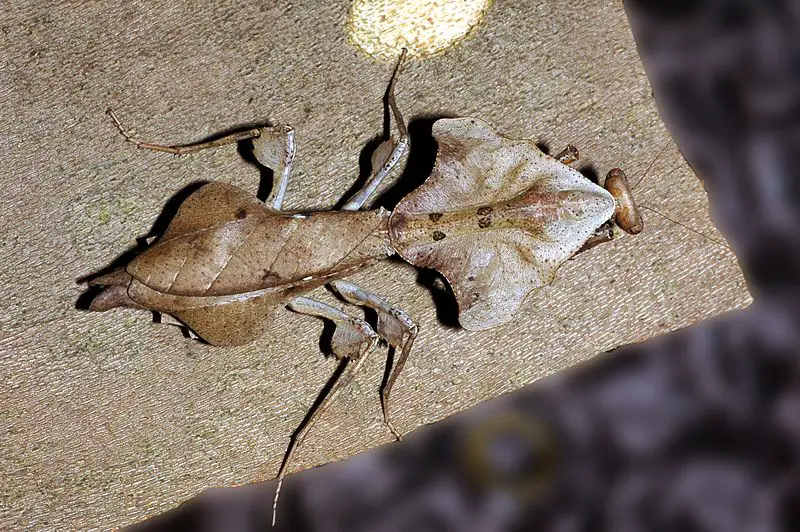
Dead Leaf Mantis Care Sheet
| Name of species | Deroplatys lobata |
| Family | Mantidae |
| Common name | European Mantis |
| Category | Mantis |
| Type | Macropterous |
| Native location | Southeast Asia |
| Temperature | 72°F to 95°F |
| Humidity | 60% to 80% |
| Size | 1.8 to 2.8 inches (4.5 to 7 cm) |
| Diet | Flying insects and small insects |
| Lifespan | Females: 2 years / Males: 1 year |
| Experience level | Beginner – intermediate |
Dead Leaf Mantis Overview
The Deroplatys lobata is commonly known as the Dead Leaf Mantis, Southeast Asian Dead Leaf Mantis, or Malaysian Dead Leaf Mantis.
In the wild, it can be found in Southeast Asia, particularly in Java, Indonesia, Thailand, Borneo, the Malay Peninsula, and Sumatra.
The DLM shares the classification of “Dead Leaf Mantis” with other mantid species that have the same camouflage mechanism; It’s also classified as macropterous thanks to its long wings.
This species isn’t a picky eater, and it’ll eat any insects it can catch as long as they’re the right size; however, they prefer flying insects such as moths and flies.
Appearance and variations
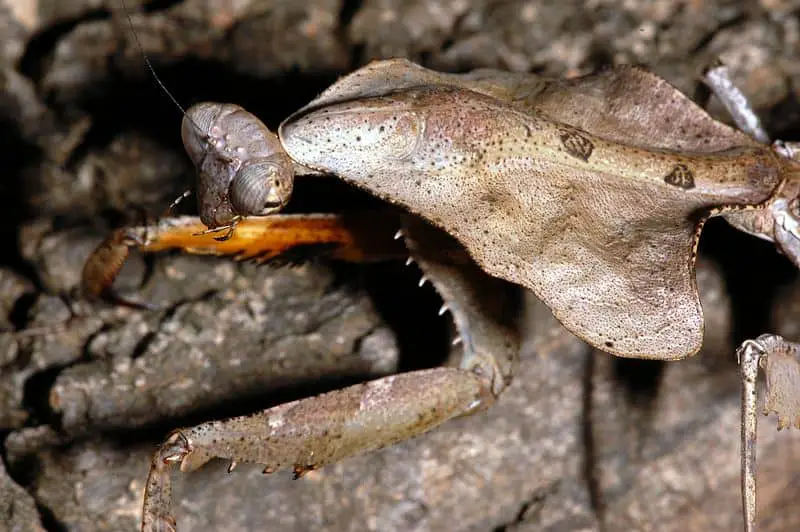
The Dead Leaf Mantis has a stunning and distinctive appearance that is often its strongest appeal for hobbyists. This mantis resembles a dead leaf with its shapes, surfaces, and colors. They have a range of possible color tones that include orangy brown, mottled brown, and different tones of gray that reach almost black.
Their prothorax is ripped to help them look like a dry leaf, unlike most mantids’ straight and smooth bodies. These adaptations make it almost impossible to tell them apart from real dead leaves when they curl their bodies and fold their legs in.
The Dead Leaf Mantis is a sexually dimorphic species. Males are smaller and thinner than females, making them more capable of flying long distances, so you must keep an eye on them or else they may get away.
Females are larger and thicker, able to fly shorter distances and fight and eat bigger prey. Besides, the female’s prothorax is wavier while the male has a diamond-shaped prothorax.
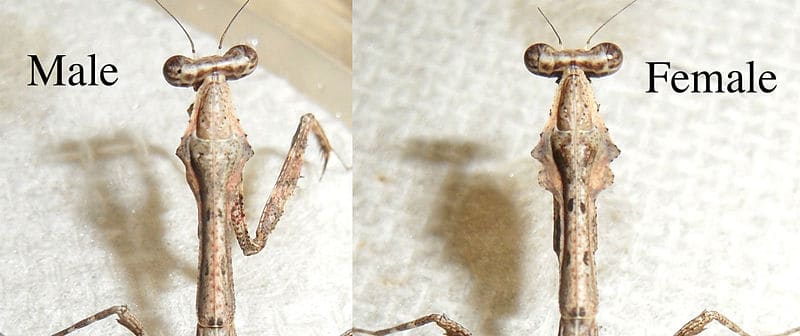
Price
The Dead Leaf Mantis is a popular pet in the hobby; there are plenty of breeders in the market, so finding a specimen is inexpensive and easy.
Nymphs go for about $10 – $15, and they’re ideal if you want to go through the insect’s complete lifecycle.
Adult specimens are slightly more expensive and often go for about $35. This is ideal for beginners since nymphs are harder to take care of.
An ootheca (a bag of eggs) is harder to find and will often have a similar price as adult specimens.
Behavior and Temperament
Thanks to its great camouflage, the Dead Leaf Mantis is often able to pass as a dead leaf to avoid threats. When their camouflage doesn’t work, adults (especially female adults) will spread out big, extending their wings or arms to look menacing in the face of their predators.
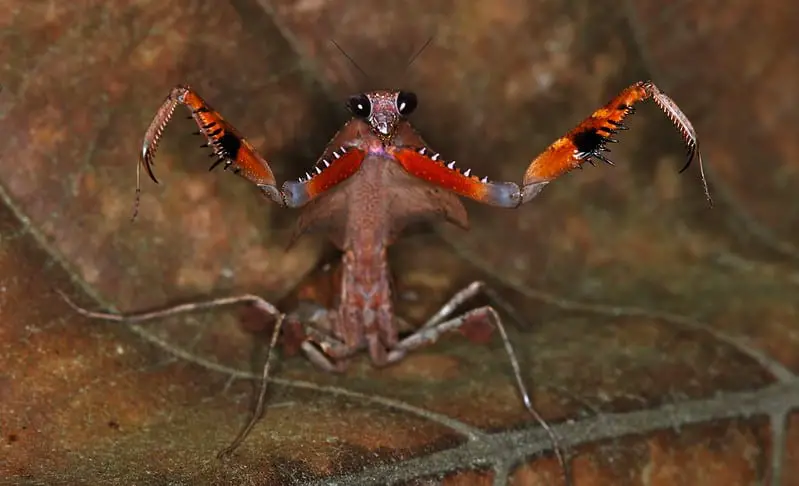
Nymphs, however, will throw themselves at the ground and stay still to resemble a dead leaf. Nymphs are also skittish, but adults have a higher tendency to remain calm and peaceful.
They’re also not aggressive to one another, so you can keep several specimens in the same enclosure and they’ll live together as long as they have enough space and food.
Like all other mantids, the Dead Leaf Mantis is harmless to human beings, and you can handle them as long as you’re careful not to harm or stress them.
Also, they can fly very well, so make sure there are no structures that may harm them mid-flight, such as ceiling fans. Of course, it’s also a good idea to close any windows or doors to prevent your mantis from escaping.
Caring for a Dead Leaf Mantis
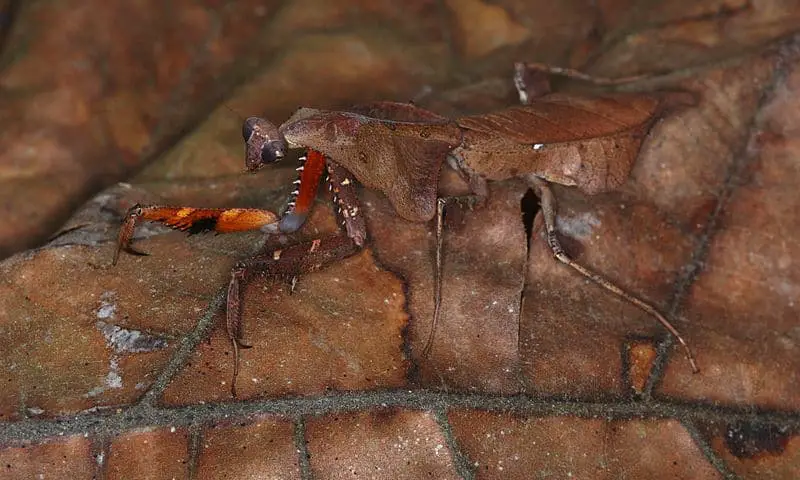
Temperature and Humidity
The Dead Leaf Mantis needs a hot and humid environment to be comfortable and healthy. Temperatures ranging between 78°F and 85°F are ideal for these beautiful mantids, though they can do okay in temperatures of up to 95°F. Make sure that the temperature does not go below 72°F for extended periods of time.
The Dead Leaf Mantis requires high high humidity, levels that are between 60% to 80% are ideal.
Unfortunately, these temperatures and humidity levels are quite a bit above room temperature conditions. As a result, supplemental heating is often required to keep the temperature up and frequent misting is necessary to keep humidity levels at adequate levels.
It’s important that you try to keep the temperature relatively constant. Huge, sudden changes in temperature can kill your mantis.
If the humidity is not high enough the mantis will have trouble molting and may get stuck and harm itself in the process.
An interesting thing about these animals is that the temperature actually affects their growth rate. A Dead Leaf Mantis kept in a warmer enclosure will grow and develop faster while one kept in a cooler enclosure will grow and develop slower but will live longer.
Substrate
One inch of substrate is enough for the Dead Leaf Mantis at all stages of development. They’re not burrowers, so the substrate isn’t very important unless you’re going for a living enclosure with real plants.
The enclosure should have good moisture retention, so peat moss and topsoil mixtures are ideal as substrate.
Tank
Since mold is a deadly problem for these mantids, you must ensure that the tank has good ventilation. Adults don’t need too much space as they’d rather stay still and wait for their prey, so a tank that’s at least three times as wide, three times as long, and three times as tall as the mantis itself is ideal.
However, if you want to keep several specimens in the same tank, you should give them more space to keep them from preying on each other.
As for the decoration, dry leaves, twigs, and branches are necessary additions for it to be comfortable. You may add fake or real plants, but make sure there are no pesticides if you use real plants, or you’ll risk harming or killing your mantis.
Watering
Misting the enclosure with water is essential to maintain humidity levels and keep water droplets over the surfaces; this way, the mantis will be able to drink water from the drops. It’ll also get hydration from its food, so placing a water dish in the enclosure is unnecessary.
Diet of a Dead Leaf Mantis
Dead Leaf Mantises are easy to feed and keep; they’re pure insectivores and should eat a variety of different insects.
What they should eat also depends on what stage of development they’re in.
- L1 and L2 nymphs should eat fruit flies
- Larger nymphs of L3 and L4 stages can eat greenbottle flies, small crickets, and small mealworms
- From L5 nymphs up to adulthood, your DLM should get bluebottle flies, medium cockroaches, moths, mealworms, or any other insects up to one-third of the DLM’s size
You can feed them as much as they’re willing to eat every three days, and make sure to clean any remains. You’ll know you’re overfeeding them if their abdomens get larger.
Molting
Like every mantis, the Dead Leaf Mantis will molt many times throughout its life. Molting is the process of shedding the exoskeleton to make way for a new one. They do this so that they can keep growing.
Molting is a natural process for all mantids, you’ll notice that your mantis is about to molt when they hang upside down from a twig motionlessly. In addition, they will refuse to eat before the molt to make the shedding of the exoskeleton easier.
During the molt, it’s very important that the enclosure is humid enough. If the enclosure is not humid enough it can lead to a failed molt which can result in lost limbs or even be fatal. In addition to humidity, it’s very important that you do not disturb them during this time so that they can molt in peace.
After the molt, refrain from feeding for around 24 hours and do not handle them for around 48 hours. This gives them time for their exoskeleton to harden.
Health & Lifespan
The female Deadleaf Mantis typically has a lifespan of about 2 years in captivity while males usually live for about a year. When kept as pets, it’s quite easy for them to live out their full lifespan as long as you care for them properly.
The most important threats to your mantis’ well-being are mold, parasites, stress, and humans. To let them thrive, it’s very important that you remove uneaten food and have adequate ventilation to prevent the buildup of mold. In addition, you should make sure that you feed them high-quality feeder insects that are captive-bred since wild-caught feeder insects can contain parasites that can be spread to your mantis.
Lastly, if you choose to handle your mantis it’s important that you’re very careful. They’re fragile insects and being too rough with them can be very damaging to them.
Communal Living
There are many reports of owners who keep the Dead Leaf Mantis communally, but this is only really recommended up to the 4th instar as long as they have enough space and are fed constantly. After the 4th instar, it’s very likely for cannibalism to occur, even if they have enough space and food.
As a result, it’s best to be safe and keep them solitarily with no more than one mantis in a single enclosure.
If you’re interested in communal mantis species I recommend checking out the Devil’s Flower Mantis or the Ghost Mantis instead since these species are much more suitable for communal living.
Fun Facts about the Dead Leaf Mantis
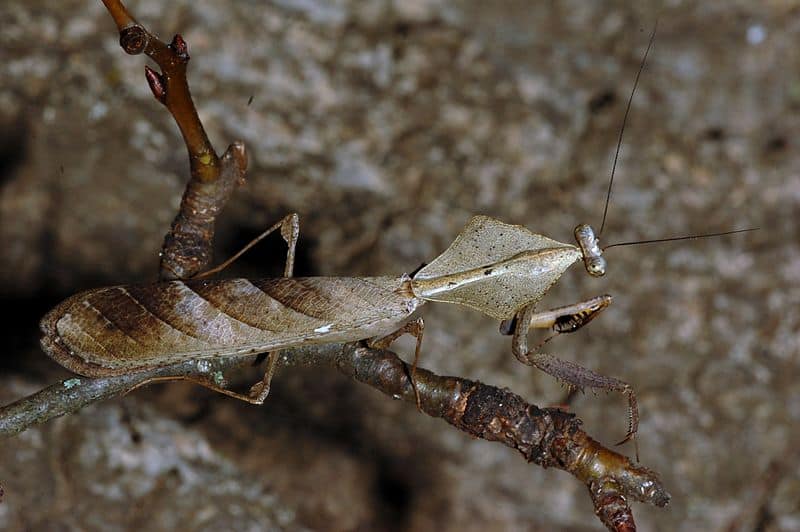
- The Deroplatys lobata is one of the few mantids that can live communally as nymphs. They’re so focused on staying hidden that they’d rather stay out of each other’s way than try to prey on each other. After the 4th instar however, they should not be housed communally.
- The DLM not only resembles a dead leaf in appearance but in behavior. It sways with the wind just like any other leaf. Also, if you try to move it with your finger, and it’s not assessing it as a threat, it’ll just topple down to the floor and stay there motionlessly.
- Female specimens of this species have been observed to watch over their oothecae after laying them. They take care of them for weeks until they hatch, keeping any predators away from their offspring.
Final words
The Dead Leaf Mantis is a beautiful addition to your collection that you won’t regret. Not only are they relatively easy to care for, but they’re also extremely cool to look at.
Their unique appearance and easy-going behavior mean that they’re suitable for beginners but also have a lot to offer to more experienced mantis hobbyists.
On top of that, they have a relatively long lifespan, which means that you’ll have plenty of time to spend with them!
Of course, it’s very possible that after reading this you decide that this species is not your cup of tea. If that’s the case, I suggest checking out the Orchid Mantis or Spiny Flower Mantis instead!
- How Long Do American Eskimo Dogs Live? Important Factors and Care Tips - September 29, 2023
- Do American Bulldogs Need Grooming? Essential Tips and Care Guidelines - September 29, 2023
- Do Bengal Cats Enjoy Playing? Essential Tips for Keeping Them Active - September 29, 2023